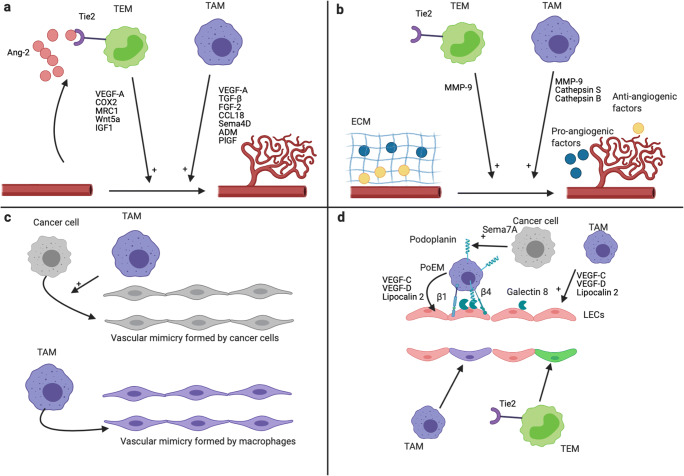Fig. 2.
Mechanisms of tumor angiogenesis and lymphangiogenesis promotion by TAMs and TEMs. Effects of TAMs and TEMs on angiogenesis (a, b, c) and lymphangiogenesis (d). a TAMs and TEMs promote tumor angiogenesis via secreted factors [5]. EC-derived Ang-2 enhances the pro-angiogenic phenotype of TEMs [58, 102]. b TAMs and TEMs promote tumor angiogenesis via the secretion of protease. TAMs secrete MMP-9, cathepsin B, and cathepsin S, whereas TEMs secrete high level of MMP-9 [58, 103–105]. MMP-9 increases VEGF-A bioavailability via ECM degradation [106, 107]. Cathepsin S is involved in the degradation of anti-angiogenic proteins and in the formation of pro-angiogenic peptides via ECM degradation [108]. The promotion of angiogenesis by cathepsin B occurs via the induction of VEGF expression by cancer cells [109, 110]. All together, these proteases lead to an increase and a decrease of pro-angiogenic factor and anti-angiogenic factor in the TME, respectively, which promote tumor angiogenesis. c Upper panel: Vascular mimicry structures are perfused non-endothelial channels. They are formed by cancer cells in several cancer types, and promote tumor growth, metastasis, and angiogenesis [111, 112]. TAMs promote, at least in vitro, the formation of vascular mimicry channels by cancer cells [113, 114]. Lower panel: TAMs can directly form vascular mimicry structures in tumors [115]. d Upper panel: TAMs promote tumor lymphangiogenesis via the secretion of VEGF-C, VEGF-D, and LCN2 [116–118]. Furthermore, podoplanin-expressing macrophages (PoEMs) are able to interact with tumor LECs and are strongly involved in the promotion of tumor lymphangiogenesis [119–121]. This interaction is dependent on GAL8 (LECs), podoplanin, and β1 and β4 integrins (PoEMs) [119, 121]. The secretion of Semaphorin 7A by cancer cells promote the expression of podoplanin by TAMs [120]. Lower panel: TEMs and a subset of TAMs (called M-LECP) are able to integrate into pre-existing lymphatics, which promotes tumor lymphangiogenesis [122, 123]. This figure was created with BioRender.com

